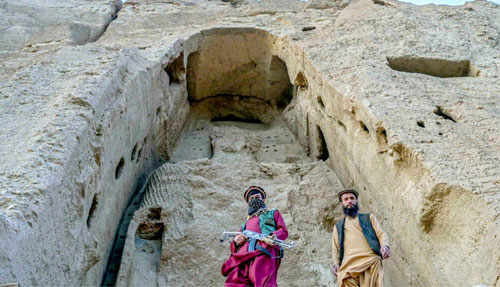The United States has restricted the import of cultural and historical items from Afghanistan, hoping to prevent “terrorists” from profiting, the State Department said on Tuesday, but experts voiced fears about unintended consequences. The decree, which was implemented on an “emergency” basis and took effect has, includes restrictions on bringing ceramics, paintings, glass, ivory, ancient textiles, tiles and wood pieces, among others, into the country, according to a government list.
“These import restrictions are intended to prevent illicitly trafficked materials from entering the US art market, thus reducing the incentive for pillage of Afghanistan’s cultural heritage and combating profit from the sale of these cultural objects by terrorists and criminal organizations,” the State Department said in a statement. The State Department said it was taking unilateral action to impose the emergency import restrictions because of “circumstances in Afghanistan”.
The US move follows an April 2021 request from the US-backed Afghan government when a collection of 33 artefacts seized from a New York-based art dealer – who authorities say was one of the world’s most prolific smugglers of antiquities – was returned to Afghanistan. “Can the State Department act based on a ‘request’ of a government that no longer exists?” ancient coin collector and advocate Peter Tompa asked in a post on his blog, Cultural Property Observer.
“The real question is how these restrictions are going to be enforced and if any material that may be seized will be repatriated to the Taliban once diplomatic relations [with the US] are restored,” he wrote. Restricted archaeological material dates from the year 50,000 BC through 1747, and restricted cultural material includes items from the ninth century through 1920, the government said.
The new regulations could create logistics issues for collectors or curators who already have items on their way to the US as auction houses prepare to sell pieces during Asia Week New York next month, art publication The Art Newspaper pointed out. Museum workers stand next to the artefacts that were smuggled to the United States during the wars and are now returned to the Afghan National Museum in Kabul, Afghanistan.Artefacts that were smuggled to the US during the wars and returned to the Afghan National Museum in Kabul, Afghanistan in April 2021, before the Taliban takeover [File: Omar Sobhani/Reuters]
For Tompa, one upside to the import rules, which are set to remain in force until April 2026 and could be extended, is that they do not seem to include bans on modern textiles. “If it did, such import restrictions would potentially devastate the livelihoods of Afghan women who make a living weaving textiles for export,” he wrote.
Last year, UNESCO called on the Taliban to help preserve Afghanistan’s cultural heritage. Shortly before their first stint in power came to an end in 2001, the Taliban destroyed two giant centuries-old Buddha statues carved out of a cliff face in Bamiyan, sparking global outrage.
And local officials and former UNESCO employees formerly based in Afghanistan told the AFP news agency that about 1,000 priceless artefacts once stored in warehouses near the statues were stolen or destroyed following the 2021 Taliban takeover.
“I confirm that looting did take place, but it was before our arrival,” local Taliban member Saifurrahman Mohammadi told AFP in October, blaming the thefts on the vacuum left by the old authorities after they fled.—Agencies










